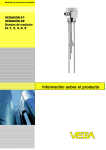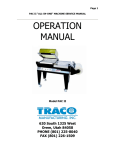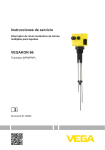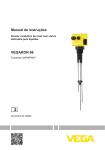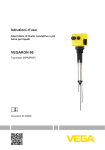Download Operating Instructions
Transcript
Operating Instructions VEGAKON 66 Safety information Safety information 2 Note Ex-area Please note the attached safety instructions, containing important information on installation and operation in Ex areas. These safety instructions are part of the operating instructions and come with the Ex approved instruments. VEGAKON 66 24377-EN-040729 Please read this manual carefully, and also take note of country-specific installation standards (e.g. the VDE regulations in Germany) as well as all prevailing safety regulations and accident prevention rules. For safety and warranty reasons, only qualified VEGA personnel must carry out any internal work on the instruments, apart from that involved in normal installation and electrical connection. Contents Contents Safety information ........................................................................ 2 Note Ex-area ................................................................................ 2 1 Product description 1.1 Function and configuration .................................................. 4 1.2 Types and version ............................................................... 4 1.3 Approvals ............................................................................. 4 1.4 Technical data ....................................................................... 5 1.5 Dimensions ........................................................................... 7 1.6 Type label ............................................................................. 7 2 Mounting 2.1 General instructions ............................................................. 8 2.2 Installation ............................................................................. 8 3 Electrical connection 3.1 Connection instructions ....................................................... 9 3.2 Connection, relay module .................................................... 9 3.3 Connection, transistor module .......................................... 10 4 Setup 4.1 Indicating and adjustment elements ................................ 12 4.2 Switching point adjustment ............................................... 12 4.3 Functions schedule ............................................................ 15 5 Diagnostics 5.1 Replacement of electronics ............................................... 16 24377-EN-040729 5.2 Simulation of switching functions ...................................... 16 VEGAKON 66 3 Product description 1 Product description 1.1 Function and configuration VEGAKON 66 conductive compact level switches detect levels of conductive liquids. Depending on the sensor electronics (module), a relay energises or deenergises or the transistor output is conductive or blocks (mode A or B) see "4.1 Indicating and adjustment elements". Max. VEGAKON can be used for reliable detection of products over a very wide conductivity and viscosity range. Min. 1.2 Types and version Application - single point control, double point control Series - compact instrument, with socket G 11 /2 A Power supply - with relay module 20 … 72 V DC 20 … 250 V AC, 50/60 Hz - with transistor module 10 … 55 V DC Output - relay module DPDT or - transistor module 1.3 Approvals CE approval VEGAKON 66 meet the protective regulations of EMC (89/336/EWG) and NSR (73/23/EWG). The conformity has been judged acc. to the following standards: EMC Emission EN 50 081 - 1 Susceptibility EN 50 082 - 2 NSR EN 61 010 General Selectable sensitivity - for adaptation to product conductivity Dry adjustment possible A/B mode Adjustable integration time Level simulation Exchangeable sensor electronics Up to three electrode rods 24377-EN-040729 4 VEGAKON 66 Product description 1.4 Technical data Mechanical configuration Housing Housing material Protection - plastic housing - aluminium housing Cable entry - with relay module (R) - with transistor module (T) Terminal plastic PBTP (Polyester) aluminium (plastic coated) IP 66 IP 66/IP 67 2 x Pg 13.5 1 x Pg 13.5 max. 1 x 1.5 mm2 Mechanical connection Socket - thread - material Electrode rod - material G 1 1/ 2 A PP 1.4571 (stainless steel) Weight VEGAKON 66 Rod approx. 0.6 kg approx. 1 kg/m Electrical configuration General data Conductance Voltage Current Integration time Mode (switchable) min. 0.5 µS/cm with 3 cm electrode covering (see "4 Setup") approx. 3 Veff max. 3 mA 0.5 … 20 s (adjustable) A: max. detection, overfill protection B: min. detection, dry run protection Transistor module 24377-EN-040729 Power supply Power consumption Output Turn-on voltage Switching current Voltage loss on the transistor Blocking current Protection class Overvoltage category VEGAKON 66 10 … 55 V DC max. 0.5 W floating transistor output overload and permanently shortcircuit proof NPN or PNP action (depending on connection) UB = max. 55 V DC I B = max. 400 mA UCE 1 V at IB 400 mA I O < 10 µA II III 5 Product description Relay module Supply voltage Power consumption Relay data - output - contact material - potential separation - turn-on voltage - switching current - breaking capacity Protection class Overvoltage category 20 … 250 V AC, 50/60 Hz 20 … 72 V DC approx. 1 … 9 VA, max. 1.5 W relay output (DPDT), 2 floating spdts AgCdO and Au plated min. 500 V DC min. 10 mV max. 250 V AC or 250 V DC min. 10 µA max. 5 A AC or 1 A DC max. 750 VA or 54 W DC I II Operating conditions Temperatures Permissible ambient temperature - relay module at operating voltage > 60 V DC Storage and transport temperature Permissible product temperature -40°C … +70°C -40°C … +50°C -40°C … +80°C -40°C … +100°C Operating pressure Max. pressure 6 bar 24377-EN-040729 6 VEGAKON 66 Product description 1.5 Dimensions 1.6 Type label (dimensions in mm) Before mounting and electrical connection, please check if you are using the correct instrument. Note the type label, it contains important data and information. The layout and details of the type label are explained in the following example. ~ 75 85 112 M20x1,5 Layout of the type label SW 60 24 VEGA® KON 66 1 2 type KON66.XG1RX electronics R power supply 20…72V DC, 20…250V AC protection IP 66 length 1000 mm 3 AB-NR. 92,5 G 1½ A ser. no. 10612892 L1 L2 L3 123456/78 4 Lmin. = 120 mm Lmax. = 4.000 mm 1 2 3 4 Master data of the order number Electronics data Order confirmation number Series number 24377-EN-040729 ø4 VEGAKON 66 7 Mounting 2 Mounting 2.1 General instructions 2.2 Installation - Seal VEGAKON on the thread in case of gauge or low pressure. Cover the thread with Teflon tape, hemp or similar or use the supplied seal ring. - Vertically mounted - In case of strong vibrations and shocks, e.g. by stirrers or turbulences in the vessel etc., it is possible that the rod of VEGAKON 66 will vibrate or swing. Make sure that with a fastening at the respective location, these vibrations are eliminated or reduced to a minimum. - With horizontal mounting, rotate the housing, so that after electrical connection, the thread connection point downward. This helps prevent moisture ingress. For this purpose, the housing is rotatable by 330°. With vertical mounting, loop the connection line(s) downward from the PG so that rain and condensation water can drain off. with one rod: For level detection in metallic vessels. The ground rod can be replaced by the ground connection to the vessel. Electrodes with a single measuring rod only serve a purpose when detection is done in viscous or highly conductive mediums - in the absence of other rods, no product bridge can form. As a rule, electrodes including an earth rod should be used for all other applications. with two rods: for level detection (min. or max.) with three rods: for pump control/double point control - laterally mounted with two rod for level detection - When mounting a VEGAKON 66 laterally, we recommend installing it approx. 20° inclined that the excess medium can drain off easily and buildup on the insulation is avoided. - In case of agitated product surfaces, foam generation or strong currents in the vessel, VEGAKON 66 should be mounted in a bypass tube. ca. 20˚ 8 24377-EN-040729 The determination of the rod lengths as well as the response height are explained under "4.2 Switching point adjustment". VEGAKON 66 Electrical connection 3 Electrical connection 3.1 Connection instructions Sensor electronics T-transistor output Danger 1 Switch off the power supply before starting any connection work. 7 2 The electrical connection must be carried out according to the type of electronics in the sensor. Connect mains voltage according to the diagrams on the following pages. 1 + 2 10...55VDC Electrostatic charge KON E66T 1 2 20...72V DC 20...250V AC + L 5 6 7 8 max. 250V AC 5A 750VA max. 250V DC 1A 54W N R 6 4 KON E66R off off off B 3 12s 6s 1 2s 0.3 A 0.1 off 3 12s 6s off 2s 0.3 A 0.1 B 10 K 30 3 100 1 off 300 TEST TEST max min 1 2 3 4 NPN - + 5 4 Floating relay output 7 3 I out max.400mA 3.2 Connection, relay module Sensor electronics R-relay output 2 - + If an electrostatic charge is likely to occur through product motion, it can be eliminated by a connection of the external ground terminal on the housing with the nearest ground potential. 1 - FUNCTION 1 2 3 4 PNP R 6 4 3 10 K 30 100 TEST 300 TEST 3 Power supply: - 20 … 250 V AC, 50/60 Hz - 20 … 72 V DC (for further information see "1.4 Technical data") Used for switching external voltage sources to relays, contactors, magnet valves, signal lamps, horns etc. max min + L1 N 5 Terminals Control lamp (LED) Rotary switch - Conductance adjustment Switch - Integration time Switch - Mode A/B Type label Strap 1 2 3 4 5 6 7 8 Relay output Power supply 24377-EN-040729 1 2 3 4 5 6 7 4 VEGAKON 66 9 Electrical connection 3.3 Connection, transistor module Floating transistor output The transistor switches a second, galvanically separated voltage source to the binary input of a PLC or to an electrical load. Power supply: - 10 … 55 V DC (for further information see the following connection examples as well as "1.4 Technical data") + + - + 1 2 3 4 + + - - 1 2 3 4 + + - - - 2 1 3 4 NPN action PNP action Connection examples Control of alternating current loads The transistor switches the supply voltage of the sensor electronics to the binary input of a PLC or to an electrical load. Through different connections of the consumer (load), PNP or NPN action can be attained. The transistor switches a galvanically separated alternating voltage 10 … 42 V AC to a load. + 1 + 1 2 3 - + 4 1 - NPN action 2 3 + - PNP action 1 3 + NPN action 10 + 4 1 - + ~ ~ - The transistor switches an alternating voltage 10 … 42 V AC, which is also supply voltage, to a load. + 1 2 3 4 2 + 3 4 - PNP action ~ ~ Note The transistor outputs of several VEGAKON can be connected in series or in parallel to combine their signals logically. The connection must be made so that terminal 2 always has a higher voltage than terminal 3. VEGAKON 66 24377-EN-040729 + 2 - 4 4 The transistor switches a second voltage source with the same reference potential to the binary input of a PLC or to an electrical load. + 2 3 - + + - Electrical connection Transistor output in conjunction with a PLC (PNP action) – – + E1.0 PLC 24377-EN-040729 VEGAKON 66 + VEGAKON 66 11 Setup 4 Setup 4.1 Indicating and adjustment elements 4.2 Switching point adjustment It is possible to check LED (2) when the housing is closed. To adjust VEGAKON, loosen the four screws on the upper side of the instrument with a screwdriver and remove the housing front cover. Switching point at approx. 1 cm immersion 1 7 Rotary switch position (sensitivity) Conductance (product) Test max. Complete immersion is simulated 0.1 kΩ > 6.6 mS 0.3 kΩ > 1.7 mS 1 kΩ > 540 µS 3 kΩ > 180 µS 10 kΩ > 54 µS 30 kΩ > 20 µS 100 kΩ > 5.7 µS 300 kΩ > 1.6 µS 2 1 3 2 20...72V DC 20...250V AC + L 6 4 5 6 7 8 max. 250V AC 5A 750VA max. 250V DC 1A 54W N R KON E66R off off off B 3 12s 6s 1 2s 0.3 A 0.1 10 K 30 100 TEST 300 TEST 3 max min 5 1 2 3 4 5 6 7 Position of the rotary switch 4 Terminals Control lamp (LED) Rotary switch - Conductance adjustment Switch - Integration time Switch - Mode A/B Type label Strap Empty condition is simulated Examples of conductance values Medium Conductance recom. rotary switch position Tap water 0.2 mS 3 kΩ Salt water (3.5 %) 35 mS 0.1 kΩ Beer 1.4 mS 1 kΩ Fruit juice 2 mS 0.3 kΩ Milk, yoghurt 3 mS 0.3 kΩ Ketchup 15 mS 0.1 kΩ VEGAKON 66 24377-EN-040729 12 Test min. Setup Determination of the response height For horizontally mounted instruments, the installation height determines the response height. For vertically mounted instruments, the response height is determined by the length of the electrode rods. Modifying the response height by changing the rotary switch setting (conductance) is not recommended. The response height can be corrected by shortening (sawing off) the measuring rods. Before shortening, the rods must be removed from the plastic threaded mounting of the sensor. The numbers of the rods are visible on the lower side of the thread. The ground rod (no. 1) should have the same length or should be even longer than the other rods. Level detection for max. signal • Fill the vessel until the shortest electrode is immersed approx. 1 cm. • Switch on the power supply. • Set the A/B switch to mode A. • Set the rotary switch to position "TEST min". • Turn the rotary switch slowly clockwise until the red LED lights. • The instrument is adapted to the medium, i.e. the relay deenergises at max. level. Level detection for max. signal • Empty the vessel until the min. electrode is immersed approx. 1 cm. • Switch on the power supply. • Set the A/B switch to mode B. • Set the rotary switch to position "TEST max". • Turn the rotary switch slowly anticlockwise until the red LED lights. • The instrument is adapted to the medium, i.e. the relay deenergises at min. level. The max. rod (no. 2) defines the response height for single point level switches or the upper switching level with double point control. 24377-EN-040729 The min. rod (no. 3) defines the lower switching level, it is always longer than the max. rod. It is missing on instruments for single point level detection. The sensor electronics recognizes if a min. rod is screwed in and changes automatically from single to double point control. VEGAKON 66 13 Setup Pump control, mode A • Fill the vessel until the shortest electrode is immersed approx. 1 cm. • Switch on the power supply. • Set the A/B switch to mode A. • Set the rotary switch to position "TEST min". • Turn the rotary switch slowly clockwise until the red LED lights. • The instrument is adapted to the medium, i.e. the relay deenergises at max. level. The relay energises again only when the level drops below the lowest point of the min. electrode. Example: A filling pump is switched on when the min. signal is reached, fills the vessel until the max. signal is reached and is then switched off. Dry adjustment With several identical measurement loop (the same medium), the adjustment of one instrument with the medium is sufficient, the determined switch position can be transferred to all further instruments. If the conductance value is known, the switching point adjustment can be carried out acc. to the schedule "Rotary switch position" (under "4.2 Switching point adjustment"). When exchanging the sensor electronics, it is sufficient to carry over the settings from the previous unit. Pump control, mode B • Empty the vessel until the min. electrode is immersed approx. 1 cm. • Switch on the power supply. • Set the A/B switch to mode B. • Set the rotary switch to position "TEST max". • Turn the rotary switch slowly anticlockwise until the red LED lights. • The instrument is adapted to the medium, i.e. the relay energises at max. level. The relay deenergises when the covering of the min. electrode is decreased. Example: An emptying pump is switched on when the max. signal is reached, empties the vessel until the min. signal is reached and is then switched off. 24377-EN-040729 14 VEGAKON 66 Setup 4.3 Functions schedule The following schedule provides an overview of the switching conditions as they relate to the set mode and level. Level Mode A Max. detection or overfill protection Switching condition relay module KON E66 R Switching conditioning transistor module KON E66 T Control lamp VEGAKON Relay energised Transistor conductive does not light Transistor blocked lights Transistor conductive does not light Transistor blocked lights Transistor blocked does not light 3 6 4 7 5 8 Relay deenergised 3 6 4 7 5 8 Relay energised Mode B Min. detection or dry run protection 3 6 4 7 5 8 Relay deenergised 3 6 4 7 5 8 Power supply failure Mode A/B Relay energised any 3 6 4 7 5 8 24377-EN-040729 Note If VEGAKON 66 is used for oil warning in water, the oil coating has to be removed from the electrode after responding to oil (= empty signal) as otherwise a correct response to water would not be ensured. VEGAKON 66 15 Diagnostics 5 Diagnostics 5.1 Replacement of electronics Replacing the electronics modules is no problem, since they are subject to narrow limits of variation and require no adaptation to other sensor (mechanical or electrical) components. Before removing the electronics module, the positions of the conductance switch, the mode switches and the integration switch should be noted. Set the new electronics module to the same values. A fresh adjustment to the medium is unnecessary. As soon as you insert the sensor electronics, the VEGAKON is ready for operation. 5.2 Simulation of switching functions With the switch positions "Test max." and "Test min.", full immersion (max.) or empty immersion (min.) can be simulated. It is not possible to move the medium. The level of the medium does not have to be raised or lowered. This enables you to check the response of the signalling and switching systems which are controlled by VEGAKON 66. Certain parts of the sensor electronics are also checked during the test. 24377-EN-040729 16 VEGAKON 66 24377-EN-040729 Notes VEGAKON 66 17 Notes 24377-EN-040729 18 VEGAKON 66 24377-EN-040729 Notes VEGAKON 66 19 VEGA Grieshaber KG Am Hohenstein 113 D-77761 Schiltach Phone (07836) 50-0 Fax (07836) 50-201 E-Mail [email protected] www.vega.com ISO 9001 All statements concerning scope of delivery, application, practical use and operating conditions of the sensors and processing systems correspond to the latest information at the time of printing. Technical data subject to alterations 24377-EN-040729




















